Editor’s note: This is the second of three installments about Scott’s Addition. The first part gave a history of the neighborhood’s early years. This installment looks at some of the district’s remaining older buildings. The final part will critique the area’s new buildings.
Westward ho!
After World War I, Richmond’s manufacturing and business operations crept west from downtown spurred by the extension of rail yards and completion in 1919 of the Broad Street Station (now the Science Museum of Virginia). In 1947, following World War II, the Richmond Chamber of Commerce reported that “Scott’s Addition was still teeming with industrial and commercial development.”
In 1954, the Triple A baseball Virginians settled at nearby Parker Field (now The Diamond). In 1956, at 3600 W. Broad St. in the Addition, the Seaboard Air Line Railroad completed its glamorous office building whose profile, if you squint, resembles a caboose. Willow Lawn and Reynolds Metals company pulled development farther out in 1957. Soon thereafter, with the opening of the federal interstate highway system, industry and warehousing pivoted to the outer suburbs here and nationwide.
The Addition, a tightly configured 152-acre mixed-use district with 245 commercial buildings, became a relatively marginalized tract in the center of the city. If one didn’t live or punch a clock there, visits to the Curles Neck Dairy for ice cream cones was the main draw for everyday people.
That would change after 2012 when the neighborhood witnessed the beginning of a dramatic transformation: Historic Rehabilitation Tax Credits made it financially attractive to convert the relentless cityscape of mostly one-story and red brick warehouses and factories into apartments, offices, breweries and restaurants. Now repopulated, there may be too many one-way streets, few paved city sidewalks, and limited green spaces, but if you examine some of the redeveloped buildings closely there are architectural delights at many turns. Some of Richmond’s most prominent architects from the first half of the 20th century designed buildings here, including Louis Ballou, Carl Messerschmidt, L. Otis Spiers, and Marcellus Wright, Sr.
Here are six older buildings in the neighborhood worth checking out:
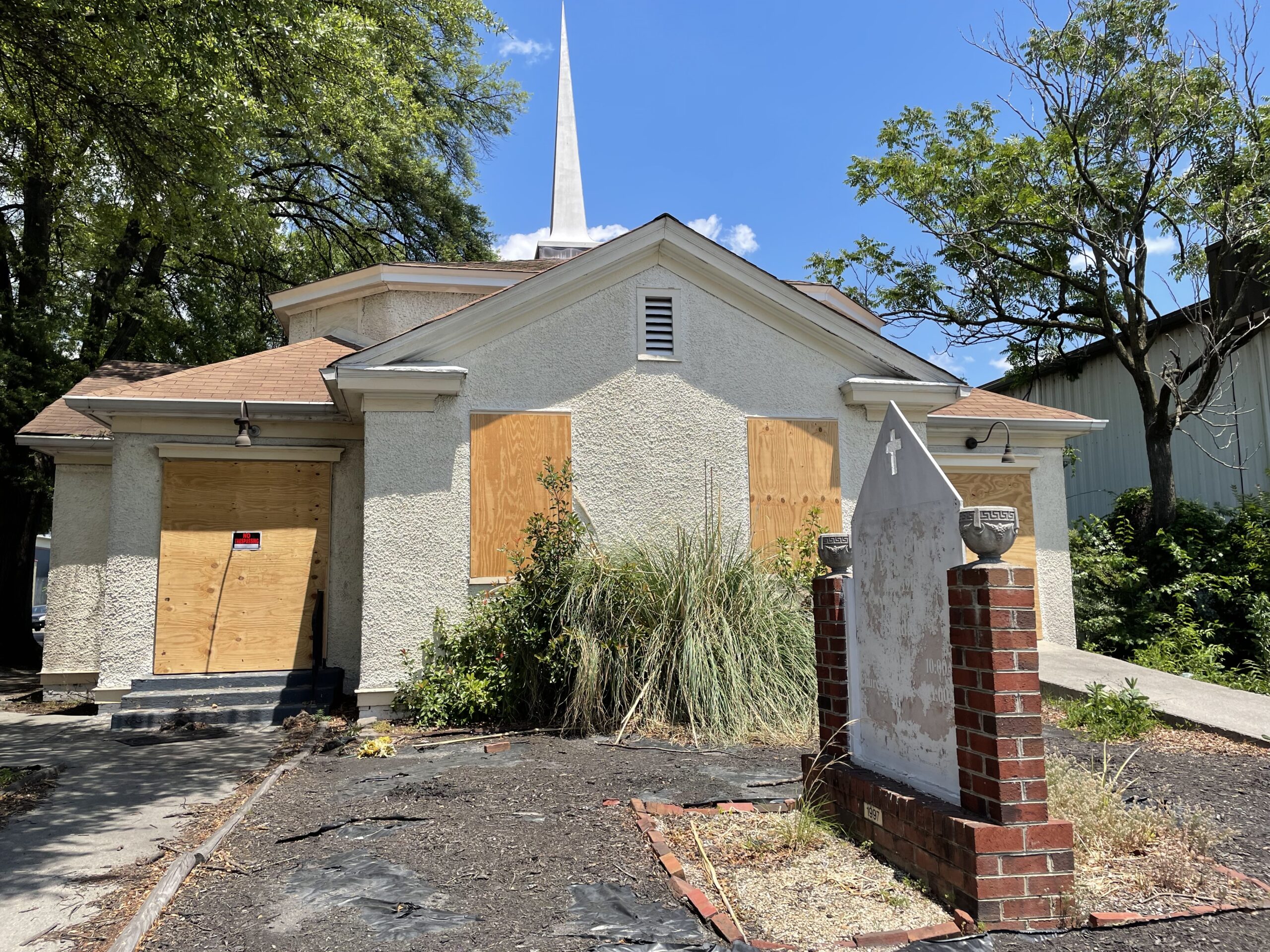
Boulevard Baptist Church, 2942 W. Marshall St.
Precious few buildings survive from Scott’s Addition’s pre-warehouse era of the 1900s and 1910s. However, a vernacular stand-out is the decaying former Boulevard Baptist Church. The 1916 stucco-faced sanctuary is fascinating in its structural complexity despite being so humble a structure. The central block of the sanctuary is an octagonal form that extends above four surrounded transepts. Despite its condition, the building exudes classical dignity worthy of a Jeffersonian plan. Two modest, concrete block educational structures facing Altamont Avenue make this a charming complex (the architects or builders are unknown). The property was recently sold to a developer who plans to build apartments on the site.
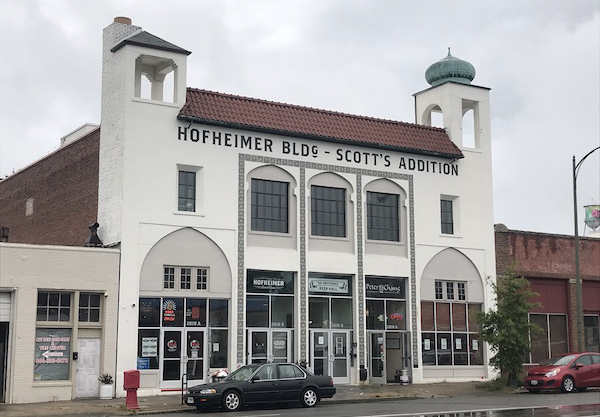
The Hofheimer Building, 2816 W. Broad St.
Architectural exoticism was in the air in Richmond during the late Roaring Twenties. The Mosque (now Altria), Byrd, and Loews (now Dominion Energy Center) theaters all but swept patrons away on magic carpet rides with their atmospheric interiors. But in Scott’s Addition the visual thrills were on the exterior at the H. R. Hofheimer Rug Cleaning & Storage building. When he designed this building young Richmonder Harold E. Calisch, who had studied architecture at the University of Pennsylvania, had returned from a trip to the Middle East with his father (Edward N. Calisch, the long-serving rabbi at Congregation Beth Ahabah). The two took lots of photos and even rode elephants on the journey. For the Hofheimer Building the architect incorporated such elements as ogive arches, an onion dome, tile roofing and stucco walls inspired by historical and holy sites father and son had visited in Jerusalem and India. For many years the building was occupied by Adams Camera Shop. In 2016 the “Hof,” as it is often called, was restored and reopened with mixed uses including an event venue, a roof deck, and the Peter Chang restaurant.
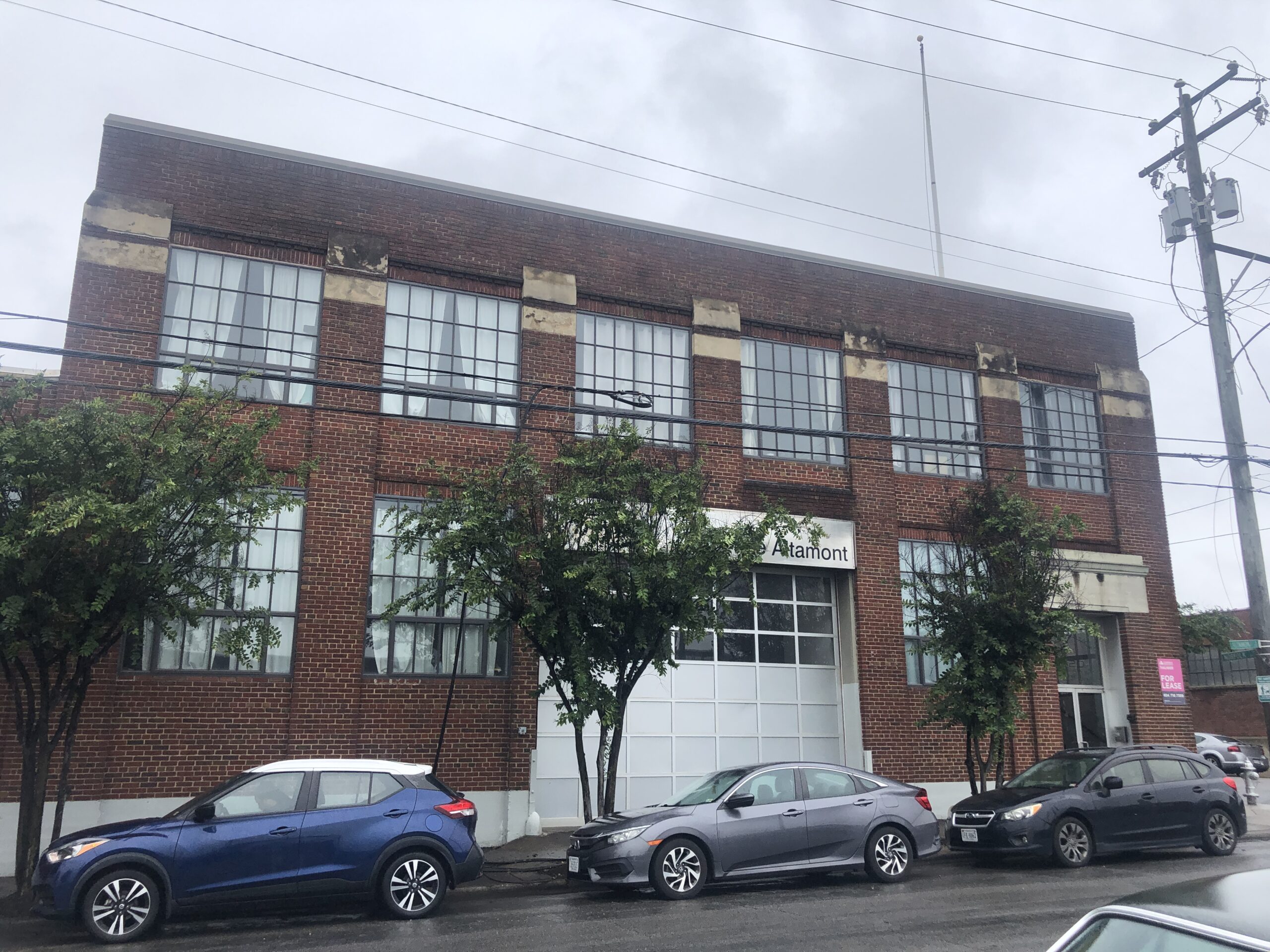
The Altamont Apartments, 1620 Altamont Ave.
Liberal outbreaks of Art Deco design occur throughout Scott’s Addition and one of the finest examples is the Altamont Apartments. The red brick structure was built in 1929 to house a Chevrolet Parts Depot. It was designed by German-born, Detroit-based Albert Kahn (1869-1942), perhaps the nation’s most prolific architect of industrial buildings. Kahn became famous and wealthy, churning out some 1,000 buildings for the Ford Motor Co. Albeit modest compared to Kahn’s Detroit projects, this well-proportioned, two-story Chevrolet facility has seven hearty brick pilasters that support concrete decorative capitals. In 1994 a successor firm, Albert Kahn Associates, designed another building in Richmond, the six-story Ethyl Corp. additive research center at Belvidere and Springs streets downtown.
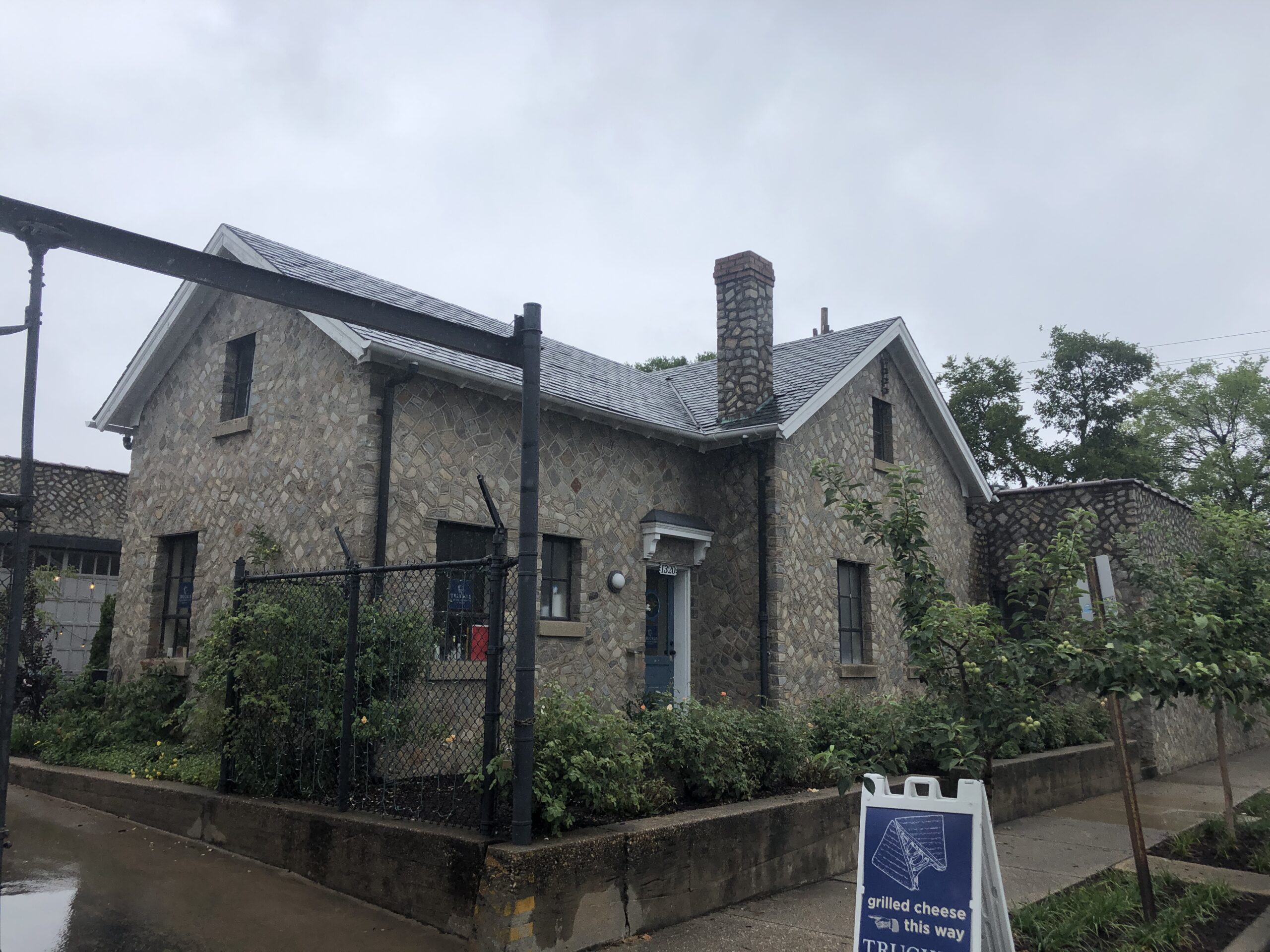
Blue Bee Cidery, 1326 Summit Ave.
Locals boast about Richmond having the world’s first major electric streetcar system, but little recognition is given to its removal and disposition of the cobblestones that once paved our city streets and held the rails in place. A spectacular example of recycling those granite blocks is found at Blue Bee Cidery. The complex began life circa 1916 as a city horse stable. In 1940 Works Progress Administration (WPA) funds were used to rebuild and expand the complex. For decades the City of Richmond recreation and parks department stored sets here for Dogwood Dell productions (in 1957 the Byrd Park amphitheater was also built incorporating cobblestones). Johannas Design Group oversaw the building’s savvy conversion to a cidery. It exudes the feeling of being in a winery in rural France.
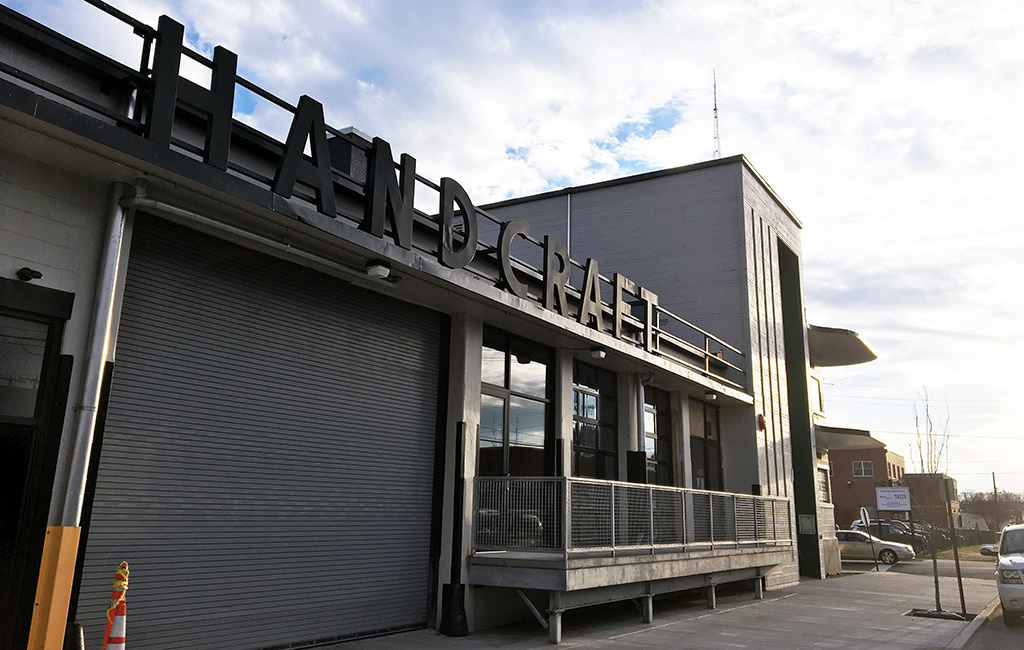
Handcraft Cleaners building, 3300 W. Leigh St.
The Handcraft Cleaners building, filling its city block on West Leigh Street, is one of Richmond’s iconic modernist buildings; it conjures the Bauhaus, the German design academy where the International Style was cultivated. This concrete block tour de force was built in 1946 for the Richmond-based Binswanger Glass Company. The building mass is divided into three sections, an office block, a glass processing center, and a wing with a glass polishing crane. The building has been sensitively renovated by 510 Architects for multiple uses. These include offices, a brewery and a Stella’s Market. A raised terrace on the Moore Street side that accommodates outdoor dining and drinking animates the street life significantly.
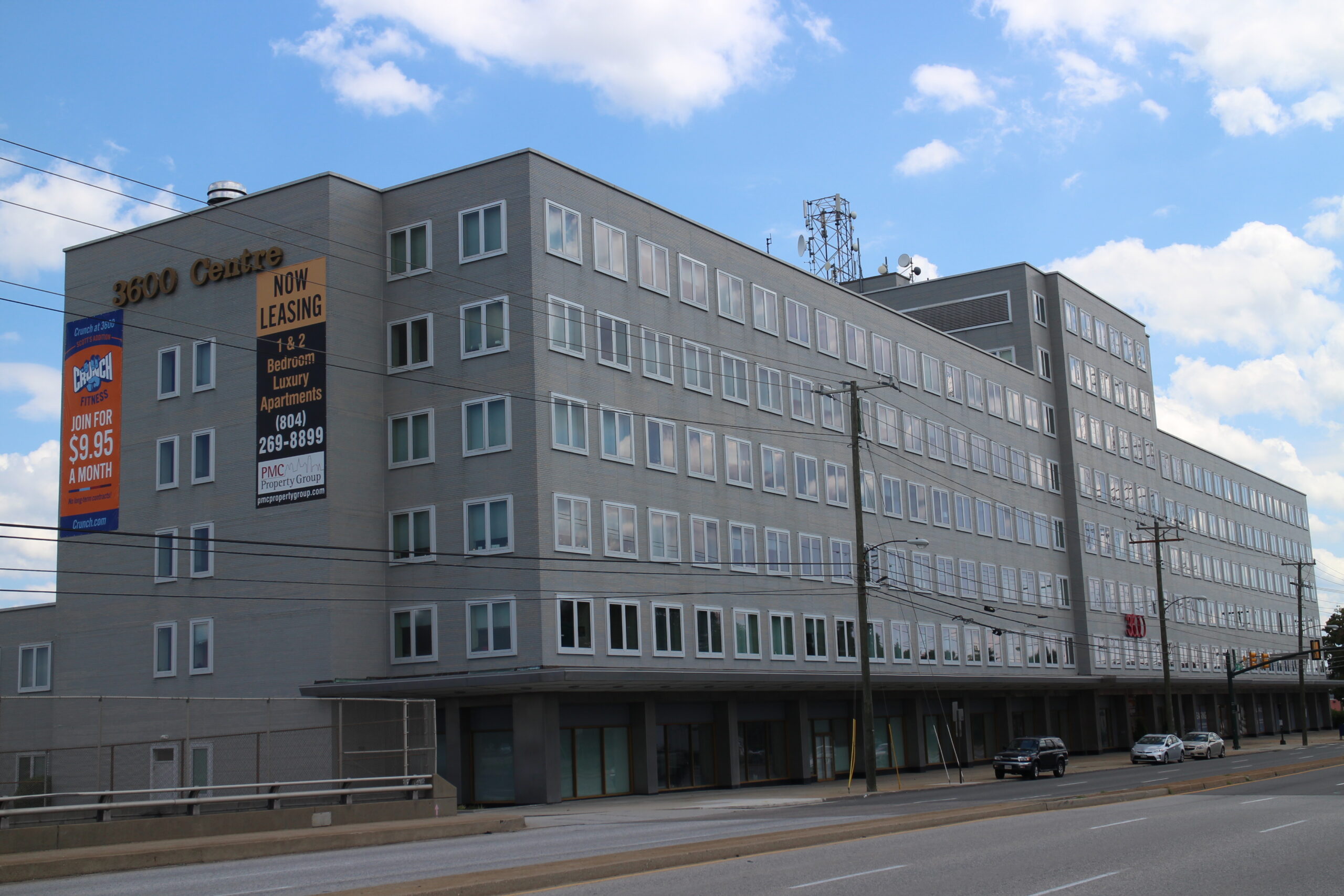 The 3600 Centre, 3600 W. Broad St.
The 3600 Centre, 3600 W. Broad St.
This massive, gray brick mid-century modern behemoth on West Broad Street was built as a regional headquarters for the Seaboard Air Line Railroad in 1956. It was one of the largest office buildings in the West End at that time. The eight-story building was designed by Baskervill and Son, a blue-chip firm that at the same time designed the Richmond Memorial Hospital (now Ginter Place condominiums) on Westwood Avenue in Laburnum Park. Both buildings have bold massing and wide aluminum surrounds augmenting prominent punched windows. A long canopy at the first floor aligns with the Broad Street sidewalk and the building firmly anchors the southwestern edge of Scott’s Addition. The modernity of the building’s materials and form is a sharp contrast to another office building, the Colonial Williamsburg confection that was built at this time three blocks west for the Home Beneficial Life insurance Company. Repurposed as the 3600 Centre in 2013, the building is now a mixed use residential complex with a Crunch Fitness gym operating day and night on the ground floor. Heave ho!
Editor’s note: This is the second of three installments about Scott’s Addition. The first part gave a history of the neighborhood’s early years. This installment looks at some of the district’s remaining older buildings. The final part will critique the area’s new buildings.
Westward ho!
After World War I, Richmond’s manufacturing and business operations crept west from downtown spurred by the extension of rail yards and completion in 1919 of the Broad Street Station (now the Science Museum of Virginia). In 1947, following World War II, the Richmond Chamber of Commerce reported that “Scott’s Addition was still teeming with industrial and commercial development.”
In 1954, the Triple A baseball Virginians settled at nearby Parker Field (now The Diamond). In 1956, at 3600 W. Broad St. in the Addition, the Seaboard Air Line Railroad completed its glamorous office building whose profile, if you squint, resembles a caboose. Willow Lawn and Reynolds Metals company pulled development farther out in 1957. Soon thereafter, with the opening of the federal interstate highway system, industry and warehousing pivoted to the outer suburbs here and nationwide.
The Addition, a tightly configured 152-acre mixed-use district with 245 commercial buildings, became a relatively marginalized tract in the center of the city. If one didn’t live or punch a clock there, visits to the Curles Neck Dairy for ice cream cones was the main draw for everyday people.
That would change after 2012 when the neighborhood witnessed the beginning of a dramatic transformation: Historic Rehabilitation Tax Credits made it financially attractive to convert the relentless cityscape of mostly one-story and red brick warehouses and factories into apartments, offices, breweries and restaurants. Now repopulated, there may be too many one-way streets, few paved city sidewalks, and limited green spaces, but if you examine some of the redeveloped buildings closely there are architectural delights at many turns. Some of Richmond’s most prominent architects from the first half of the 20th century designed buildings here, including Louis Ballou, Carl Messerschmidt, L. Otis Spiers, and Marcellus Wright, Sr.
Here are six older buildings in the neighborhood worth checking out:

Boulevard Baptist Church, 2942 W. Marshall St.
Precious few buildings survive from Scott’s Addition’s pre-warehouse era of the 1900s and 1910s. However, a vernacular stand-out is the decaying former Boulevard Baptist Church. The 1916 stucco-faced sanctuary is fascinating in its structural complexity despite being so humble a structure. The central block of the sanctuary is an octagonal form that extends above four surrounded transepts. Despite its condition, the building exudes classical dignity worthy of a Jeffersonian plan. Two modest, concrete block educational structures facing Altamont Avenue make this a charming complex (the architects or builders are unknown). The property was recently sold to a developer who plans to build apartments on the site.

The Hofheimer Building, 2816 W. Broad St.
Architectural exoticism was in the air in Richmond during the late Roaring Twenties. The Mosque (now Altria), Byrd, and Loews (now Dominion Energy Center) theaters all but swept patrons away on magic carpet rides with their atmospheric interiors. But in Scott’s Addition the visual thrills were on the exterior at the H. R. Hofheimer Rug Cleaning & Storage building. When he designed this building young Richmonder Harold E. Calisch, who had studied architecture at the University of Pennsylvania, had returned from a trip to the Middle East with his father (Edward N. Calisch, the long-serving rabbi at Congregation Beth Ahabah). The two took lots of photos and even rode elephants on the journey. For the Hofheimer Building the architect incorporated such elements as ogive arches, an onion dome, tile roofing and stucco walls inspired by historical and holy sites father and son had visited in Jerusalem and India. For many years the building was occupied by Adams Camera Shop. In 2016 the “Hof,” as it is often called, was restored and reopened with mixed uses including an event venue, a roof deck, and the Peter Chang restaurant.

The Altamont Apartments, 1620 Altamont Ave.
Liberal outbreaks of Art Deco design occur throughout Scott’s Addition and one of the finest examples is the Altamont Apartments. The red brick structure was built in 1929 to house a Chevrolet Parts Depot. It was designed by German-born, Detroit-based Albert Kahn (1869-1942), perhaps the nation’s most prolific architect of industrial buildings. Kahn became famous and wealthy, churning out some 1,000 buildings for the Ford Motor Co. Albeit modest compared to Kahn’s Detroit projects, this well-proportioned, two-story Chevrolet facility has seven hearty brick pilasters that support concrete decorative capitals. In 1994 a successor firm, Albert Kahn Associates, designed another building in Richmond, the six-story Ethyl Corp. additive research center at Belvidere and Springs streets downtown.

Blue Bee Cidery, 1326 Summit Ave.
Locals boast about Richmond having the world’s first major electric streetcar system, but little recognition is given to its removal and disposition of the cobblestones that once paved our city streets and held the rails in place. A spectacular example of recycling those granite blocks is found at Blue Bee Cidery. The complex began life circa 1916 as a city horse stable. In 1940 Works Progress Administration (WPA) funds were used to rebuild and expand the complex. For decades the City of Richmond recreation and parks department stored sets here for Dogwood Dell productions (in 1957 the Byrd Park amphitheater was also built incorporating cobblestones). Johannas Design Group oversaw the building’s savvy conversion to a cidery. It exudes the feeling of being in a winery in rural France.

Handcraft Cleaners building, 3300 W. Leigh St.
The Handcraft Cleaners building, filling its city block on West Leigh Street, is one of Richmond’s iconic modernist buildings; it conjures the Bauhaus, the German design academy where the International Style was cultivated. This concrete block tour de force was built in 1946 for the Richmond-based Binswanger Glass Company. The building mass is divided into three sections, an office block, a glass processing center, and a wing with a glass polishing crane. The building has been sensitively renovated by 510 Architects for multiple uses. These include offices, a brewery and a Stella’s Market. A raised terrace on the Moore Street side that accommodates outdoor dining and drinking animates the street life significantly.
 The 3600 Centre, 3600 W. Broad St.
The 3600 Centre, 3600 W. Broad St.
This massive, gray brick mid-century modern behemoth on West Broad Street was built as a regional headquarters for the Seaboard Air Line Railroad in 1956. It was one of the largest office buildings in the West End at that time. The eight-story building was designed by Baskervill and Son, a blue-chip firm that at the same time designed the Richmond Memorial Hospital (now Ginter Place condominiums) on Westwood Avenue in Laburnum Park. Both buildings have bold massing and wide aluminum surrounds augmenting prominent punched windows. A long canopy at the first floor aligns with the Broad Street sidewalk and the building firmly anchors the southwestern edge of Scott’s Addition. The modernity of the building’s materials and form is a sharp contrast to another office building, the Colonial Williamsburg confection that was built at this time three blocks west for the Home Beneficial Life insurance Company. Repurposed as the 3600 Centre in 2013, the building is now a mixed use residential complex with a Crunch Fitness gym operating day and night on the ground floor. Heave ho!



It’s always great to see our city through Ed Slipek’s eyes. I hope that little church continues to have a home in Scott’s.
It is scheduled to be demolished as part of the Chasen’s property redevelopment.
It would be neat if the little church building could somehow be relocated to a different place, but that would be extremely expensive and time consuming.
As a Richmond native, I sometimes wondered about the origin of these buildings and architectursl styles. Thanks, Ed, for an insightful and well-written overview.
I really enjoy any article by Ed Slipek! This one was particularly fascinating.
Once again, a fantastic journey set before us by Dr. Slipek. I love how he weaves a tapestry of the fabric of a neighborhood to give us a glimpse at the deeper history and the rare gems that lay within. Really enjoyed the article.
Eddie Slipek always finds the most interesting architectural and historical aspects to Richmond’s built environment. Great coverage of some buildings we all see but may not really know.
The former Seaboard Building (3600 Centre) was the main headquarters of the SAL, not just a regional headquarters. And, it wasn’t just the largest office building “in the West End”, but in all of Richmond for decades. It’s not tall, and it’s a little deceptive, but it is indeed massive.
It was the corporate headquarters of combined CSX until they moved to the James Center in mid 1990s.